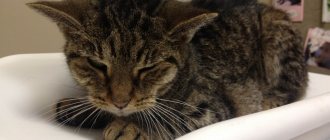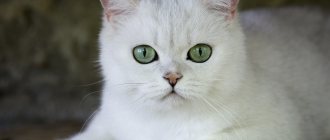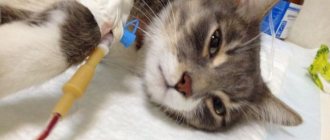Types of glomerulonephritis
There are three varieties:
- Acute – characterized by a rapid onset and pronounced clinical manifestations.
- Subacute – has a milder and more gradual onset, symptoms are mild.
- Chronic is a fairly rare form that can last a long time, over months or years, and is manifested by periodic exacerbations in an acute form. Leads to the development of “wrinkled” kidneys and chronic kidney disease (CKD).
A rapidly progressive form is also isolated separately; it has a malignant course and quickly turns into acute renal failure, often with a fatal outcome.
Treatment regimen for nephritis in cats
A sick pet should be kept warm during therapy. In any case, it is impossible to let the animal go outside, especially in the winter season. In the acute form of the disease, veterinarians first prescribe a 12-hour fast for cats.
With nephritis, the animal usually experiences quite severe pain. Therefore, in most cases, such pets are prescribed analgesics and antispasmodics. Actually, the treatment of nephritis itself is carried out using broad-spectrum antibiotics, hormones and sulfonamides. The cat may also be prescribed iron and calcium supplements and diuretics. In some cases, nephritis may even require surgery.
Folk remedies also help cats with kidney inflammation very well. For example, you can offer your animal a warm infusion of bearberry or lingonberry leaf.
A little about the disease
The basis for the development of the disease is the antigen-antibody complex, which is formed by one’s own immune system. These formations begin to accumulate in the glomeruli, as well as directly in the capillaries of the glomeruli. Due to these processes, the defense system is activated, which causes a massive release of neutrophils, macrophages, platelets and fibrin deposition. These processes damage the glomeruli.
To protect damaged tissues, proliferation (growth) of the endothelium and thickening of the membrane begin, which, with further progression of damage, turn into sclerosis and hyalinization. The latter are characterized by increasing renal failure.
Causes
There is still no exact reason for such an “incorrect” immune response in primary glomerulonephritis; there are a number of provoking factors and activating agents.
These also include etiological factors for the occurrence of secondary glomerulonephritis:
- Infections - most often these include dirophyllariasis, leishmaniasis and ehrlichiosis.
- Neoplasms.
- Systemic autoimmune lesions – systemic lupus erythematosus.
- Toxic or drug damage.
- Sudden hypothermia, for example, during a long stay in the cold or finding a wet cat in a cold room.
- Inflammatory kidney diseases.
- Endocrine diseases - damage to the adrenal glands or thyroid gland, diabetes mellitus.
- Long-term use of hormonal drugs (glucocorticosteroids).
Symptoms
Glomerulonephritis has a broad clinical picture, since the disease process involves not only the kidneys, but also the cardiovascular system, visual analyzer, blood system and endocrine organs.
Also, the severity of symptoms depends on the degree of damage, the duration of the process and the amount of proteinuria (protein in the urine). Often, glomerulonephritis is detected at the initial stage during screening tests.
If proteinuria is moderate, rather nonspecific signs are observed:
- Losing weight.
- Lethargy.
- Decreased appetite.
Often this course, without obvious clinical manifestations, leads to the development of a chronic disease.
The acute phase of the disease is characterized by:
- Pain in the lumbar region can be either minor and dull, or with severe manifestations and depression of the cat’s condition.
- Difficulty urinating and urine that is the color of “meat slop” (due to the presence of blood in it). The animal has frequent urges with a small amount (oliguria) or absence (anuria) of urine.
- “Volatile” swelling - has different localization, which can change over time - for example, in the morning there is swelling in the lower back and abdomen, and in the evening they are located on the limbs.
- Disorders of the gastrointestinal tract - vomiting, diarrhea.
- Arterial hypertension.
- Possible changes in the functioning of the heart - arrhythmia, tachycardia and shortness of breath.
- Sudden rise in temperature and fever.
In severe cases, acute glomerulonephritis can result in uremic coma due to an increase in the concentration of nitrogen in the blood and the death of the animal.
On average, the disease lasts 2 weeks, after which complete recovery occurs, transition to a chronic form, or death of the pet.
In the chronic form, the disease progresses due to an increase in the number of affected nephrons, when ¾ of the total number of defective nephrons is reached, renal failure develops. Chronic glomerulonephritis does not occur with an increase in temperature, but has all the signs of an acute course, but in a more diffuse form.
The chronic course is divided into several clinical forms:
- Nephrotic – caused by severe inflammatory processes and their combination with nephrotic syndrome (oliguria, proteinemia, edema and blood in the urine).
- Hypertensive – the leading symptom is arterial hypertension without pronounced manifestations of kidney disease.
- Latent – almost complete absence of symptoms and a long latent course, inevitably leading to chronic renal failure.
- Hematuric - the main symptom is blood in the urine, against the background of a mild increase in protein in the blood and urine.
- Mixed - usually combines symptoms of nephrotic and hypertensive forms.
With rapidly progressing glomerulonephritis, a malignant form occurs, which forms acute renal failure.
Why does nephritis develop?
The disease is characterized by an inflammatory process in the parenchyma, tubules, glomeruli, and renal pelvis. The disease is divided into the following subtypes:
- Spicy. The pathological process develops suddenly and has a purulent, diffuse and focal form.
- Chronic. The disease alternates between periods of exacerbation and remission.
Kidney nephritis in cats occurs both as an independent disease and as a result of other pathologies. There is also interstitial nephritis, which has a non-infectious etiology and occurs as a result of nephrosclerosis - a pathological decrease in organ size. Inflammatory kidney damage also includes glomerulonephritis and pyelonephritis. Causes:
Infection of a pet with leptospira often leads to such a disease.
- entry and activation of pathogenic bacteria and viruses - staphylococci, salmonella, leptospira, streptococci;
- uncontrolled use of medications;
- helminthiasis;
- overdose of flea chemicals;
- poisoning by alkalis, poison from insects and rodents;
- houseplants that are poisonous to cats;
- food is of poor quality or expired;
- inflammation of the genitourinary system;
- decreased immunity;
- hypothermia;
- dermatitis of various etiologies.
Diagnostics
One of the first diagnostic methods is a general urine test; it helps to recognize glomerulonephritis in the early stages, when there are no clinical manifestations. Typically, when diagnosed positively, a high amount of protein, red blood cells, white blood cells and casts are found.
It is also important to take a general and biochemical blood test. It shows the amount of protein and nitrogenous bases.
Changes in the kidneys can be detected by ultrasound. In addition, this method allows you to differentiate the disease from pyelonephritis and kidney stones.
To determine the infection, a bacterial urine culture should be performed.
It is also advisable to conduct a blood test to detect feline leukemia viruses, FIV (feline immunodeficiency virus), and infectious peritonitis.
If after all the tests it is not possible to make an accurate diagnosis, then a kidney biopsy is performed. It helps to accurately separate glomerulonephritis from amyloidosis.
After a biopsy, the morphological identity of the disease can be determined:
- Membranous - characterized by thickening of the walls of capillaries and membranes.
- Proliferative (edematous) – pronounced proliferation of renal glomerular cells.
- Membranous-proliferative.
How to calculate the required number of calories
REP - resting energy requirements (number of calories) a cat needs at rest for good metabolism is calculated using the formula.
30 cal x cat’s weight in kg +70 cal
- Cat weight 5 kg – 30 x 5 + 70 = 220 - this is the cat’s PEP
- Kitten weight 1 kg – 30 x 1 kg + 70 = 100 – this is the kitten’s PEP
- A cat with emaciation of 3.5 kg - 30 x 3.5 + 70 = 175 - this is the cat's PEP
- Overweight cat 6.5 kg – 30 x 6.5 + 70 = 265 – this is the cat’s PEP
EPE - the daily energy requirements required by your cat depend on age and condition, summarized in a table.
In cats, especially older ones, diseases of the urinary system are relatively common. And they are fraught with many unpleasant effects, including chronic poisoning by metabolic products, exhaustion, complete organ failure and death. In short, the prospects are unpleasant. Therefore, glomerulonephritis in cats (or suspicion of it) is an excellent reason to immediately take your pet to the veterinarian!
You should start with a short course in anatomy and physiology. So what are kidneys? These are organs that got their name due to their external similarity to tree buds, and perform the most important excretory function. They synthesize urine, with which nitrogenous bases, bilirubin, toxins and other metabolic products are released into the external environment.
The bulk of this work lies with the glomeruli. These are the morphofunctional units of the organ. They are a kind of molecular filters. In the process of their work, two types of urine are formed: primary, similar in composition to blood plasma, and secondary, directly released into the external environment during the act of urination. There are millions of glomeruli in the kidneys. When these structures are damaged, kidney function is significantly impaired, and toxins in the blood rapidly increase, causing many severe effects.
Attention!
Glomerulonephritis is precisely the name given to inflammation of the glomeruli. In cats, a common cause of this disease is autoimmune pathologies, in which the kidneys are attacked by the body's defense system.
Treatment
One of the first methods of treatment for acute glomerulonephritis is the correct therapeutic diet. In the first days, the cat should completely limit feeding, giving only warm water. After two days, you can slowly introduce food, limiting proteins and salt in the diet. You can introduce oatmeal with water, vegetable purees. Then gradually add dairy products, soups with cereals and vegetables to the menu. After a week, you can give lean meat.
If your cat is on a commercial diet, consult your veterinarian about the recommended brand of medical food. Typically, food comes with the prefix “renin” or for cats with renal pathology.
The diet must include vitamins A, C, E and group B.
Typically, glucocorticosteroids are used to stop the formation of immune complexes. It is worth prescribing high dosages first for a long time, followed by their abolition when the dose is reduced. It is also possible to prescribe cytostatics - chlorambucil.
To relieve intoxication, drip infusions of glucose solutions and Cartman's solution are prescribed. In case of severe intoxication, bloodletting is used, followed by the administration of glucose. Cartman's solution or glucose is prescribed as a subcutaneous injection for a week.
For arterial hypertension, enalapril is used - 0.5 mg/kg once a day.
When the disease develops against the background of an infectious process, antibiotics are used; I usually prescribe nitrofurans or penicillins to cats. If there is no therapeutic effect, they switch to 3rd generation cephalosporins.
If cardiovascular failure has developed, cardiac glycosides (cordigit, digoxin) are administered.
Diuretics are used to stimulate diuresis - veroshpiron, furosemide (50 mg once a day).
To relieve pain when the animal is restless, injections are given with baralgin, cystone or no-shpu.
If blood is detected in the urine, drugs are used to stop bleeding - aminocaproic acid (intravenous drip), vikasol, dicinone.
Prevention
- Provide a warm and dry room where the animal is kept, free from drafts
- Rational use of medications, strictly following doctor's prescriptions.
- Do not bathe your cat during the cold season or when there is no heating in the house.
- Protect your pet from hypothermia.
- Do not allow toxic or poisonous substances to enter your food.
- Proper use of hormonal drugs.
- Monitor blood pressure and undergo frequent urine tests.
- Ensuring a balanced diet and drinking regime.
Videos and illustrations
"Chronic glomerulonephritis in dogs and cats", R. Leonard
Arterial hypertension with glomerulonephritis
Changes on ultrasound
Acute glomerulonephritis
Therapeutic measures
The ideal treatment for glomerulonephritis in cats is to find and eliminate the root cause of this pathology. Alas, such an outcome is extremely rare, since the same autoimmune pathologies are very difficult to identify (and many veterinarians have neither specific experience nor equipment).
General therapeutic techniques include the following:
- Prescribing immunosuppressants to inhibit the inflammatory response and block possible autoimmune pathology.
- With extreme caution - microscopic doses of aspirin (veterinarian only!). The drug reduces the risk of thrombosis and reduces the intensity of the inflammatory reaction.
- Prescription of polyunsaturated fatty acids, which relieve inflammation and reduce the intensity of proteinuria.
- Prescription of elanapril for cats suffering from arterial hypertension.
- It is useful to put your cat on a special diet. The feed should contain a minimum amount of protein, phosphorus and sodium.
What is the prognosis for this disease? It all depends on the condition of the animal, its age, diet, and the timeliness of the treatment started. If it has not reached nephrotic syndrome, then the chances of recovery are high. Otherwise, there is a high risk of developing chronic renal failure. So we advise you to show your cat to the veterinarian more often!











